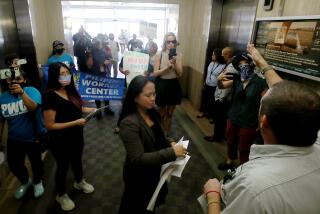Workers’ Comp Often Too Little, Report Finds
- Share via
Californians injured at work face severe financial problems, often falling into lower-paying jobs, weathering long bouts of unemployment and even dropping out of the labor force, according to preliminary findings of a groundbreaking study of the state workers’ compensation system.
In the first five years after reporting permanently disabling injuries, workers lose an average 40% in wages, yet get just over one-third of that money back in benefits, according to the state-funded report by the Rand Corp., a Santa Monica-based think tank.
Experts said the research provides powerful evidence of how the state workers’ compensation system has let workers down, while permitting wasteful spending that drives up expenses for employers.
The study, which cost $450,000 and has been in the works for 16 months, is scheduled to be released in time for a special summit of state officials, business and labor leaders and other interest groups Nov. 21 in San Francisco.
It is expected to trigger calls for another overhaul in the way California treats people with permanently disabling work injuries.
“We’re seriously undercompensating the vast majority of these workers,” said Mark A. Peterson, a co-author of the study.
However, calls for more money for benefits could drive up insurance premiums for employers and ignite new political battles between businesses and advocates for injured employees.
The California workers’ compensation system, which dates back to 1913, was crafted to replace lost wages and, when necessary, provide long-term medical care to injured employees. It sharply limits employers’ legal liability, providing an enormous saving to business.
But, the report says, under the current program, benefits come close to replacing lost wages only for workers with the most serious disabilities.
Rand’s research marks the first time that California--and one of the few times that any state--has systematically studied how much money workers with permanent partial disabilities lose in wages.
The study also represents the first objective economic assessment of what social workers, rehabilitation specialists, lawyers and others who work with or represent injured California workers have reported anecdotally for years.
These specialists say that disabled workers’ lives are permanently shaken, taking a toll on their family lives and often leading to dependence on welfare and other government assistance.
The study analyzed thousands of workers’ compensation cases from 1992 through 1996 and compared the wages earned by the injured people with the earnings of a comparable group of healthy workers.
Officials estimate that 200,000 employees in the state suffer injuries every year that lead to permanent disabilities. Although the vast majority of those disabilities are minor, the report underscores that such ailments still lead to wage losses.
Although no figures are available on the overall losses, one researcher familiar with the study put the tab at more than $4 billion annually.
“The system doesn’t keep its promise,’ said Marvin Shapiro, a lawyer who represents injured workers and is an instructor at the USC law and medical schools.
“[The Rand study] says the bargain that was cut between employers and employees has worked fine for employers--they now have competitive rates--but the savings have not been passed on to the people that society forgets, the injured workers,” he said.
*
But Julianne A. Broyles, a lobbyist for the California Chamber of Commerce, countered that major employers have long supported improved benefits for seriously injured workers.
She said she was encouraged by the report’s call for streamlining the workers’ compensation system and cutting costs for employers by reducing unnecessary litigation.
“What we’ve always strived for is a less litigious system,” she said.
Researchers found that most of the economic losses are suffered by workers with what are considered less serious, albeit permanent, disabilities--a category that can include such problems as carpal tunnel syndrome, back injuries, blindness in one eye or loss of a finger.
For instance, the study found that, on average, a worker suffering an amputated finger on the job received $3,600 in financial compensation, on top of an undetermined amount of medical care.
But the report said the wages lost by workers who lose fingers sometimes amount to nearly $30,000.
John Mynes, a former baggage handler at Los Angeles International Airport, was injured three years ago when a large, heavy box suddenly rolled off a conveyor belt.
“I turned and tried to shove it out away from my body--and I ripped in half the rotator muscle that controls my shoulder and arm,” Mynes said.
*
The Brea resident, 56, said his life hasn’t been the same. A doctor treated him for a minor muscle sprain, and though he was still in great pain, sent him back to work, he said. Later, he lost his job, went on medical leave and ended up on state disability, he said.
Two months ago, he gained employment as a retail clerk, earning $7 an hour, with no benefits. His airline position used to pay more than twice that, included full benefits and promised him retirement based on 30 years in the job.
He figures that the $18,000 settlement he received through the workers’ compensation system can’t begin to make up for the hundreds of thousands of dollars in lost future wages. He and his wife are considering moving to a state with a lower cost of living.
The study also found that many partially disabled employees fall out of the labor force. Workers who claimed permanent partial disabilities in 1992, according to the research, were 25% less likely to be holding jobs than comparable able-bodied workers.
Robin Weigand, 37, and her three children were evicted from an apartment after she severely injured her back while working as a retail clerk. Now the family lives in a Garden Grove hotel room.
*
Weigand said they survive on her child support payments and her 19-year-old daughter’s income as a telemarketer.
“I don’t feel like a human being any more,” Weigand said.
The earnings lost by being out of the labor force accounted for much of the overall estimated wage decline of 40% among the disabled workers studied from 1992-1996. But another part of the wage losses resulted from the lower pay received by disabled employees who returned to work.
By one account, permanently disabled employees who kept working received wages that were about 20% less than those of their able-bodied counterparts.
“It’s very unfair--what they’ve done to me,” said Juan Cienfuegos. The Merced resident said he was making about $12.50 an hour, with benefits, when he twisted his knee in a factory accident five years ago.
After surgery to remove damaged cartilage, Cienfuegos said, he was put back on heavy-duty work despite doctor’s orders that he remain on light duty. He said his knee swelled, he was forced to have more surgery, and he lost his job.
He started last April as a cabinetmaker’s assistant, at $7.50 an hour, with no benefits.
*
Last summer, he received a $20,000 settlement to cover lost wages and lawyer’s fees--and lifetime medical coverage for his knee. He figures that if, instead, he had been working since the accident at his former factory job, he would have earned a total of $90,000 more.
Given the complicated politics of workers’ compensation, observers say, it will be difficult, if not impossible to accomplish major reforms in Sacramento over the coming year. Reform efforts have traditionally been complicated by the vast array of interest groups involved.
Still, said John Duncan, acting director of the California Department of Industrial Relations: “This is the beginning of a much needed debate.”
More to Read
Sign up for Essential California
The most important California stories and recommendations in your inbox every morning.
You may occasionally receive promotional content from the Los Angeles Times.










